
I have been vegetarian or pescatarian for most of my adult life, so I am no stranger to falafel. Thought (with some debate) to originate in Egypt, modern felafel is made from soaked chickpeas (although it was originally made with fava beans). As most of us with FODMAP constraints know, soaked chickpeas are off limits on the FODMAP diet (and fava beans are even more off limits!). To ensure we all get our falafel fix, I have come up with this low FODMAP falafel recipe that tweaks the dish for the low FODMAP diet.
A quick note, before we dive in: my intention in tweaking recipes from other cultures is never to take from a cuisine or to cause any offence. My aim for this website is simply to provide delicious recipes for people who have many dietary constraints at once. Any tweaks I make are solely for FODMAP purposes.
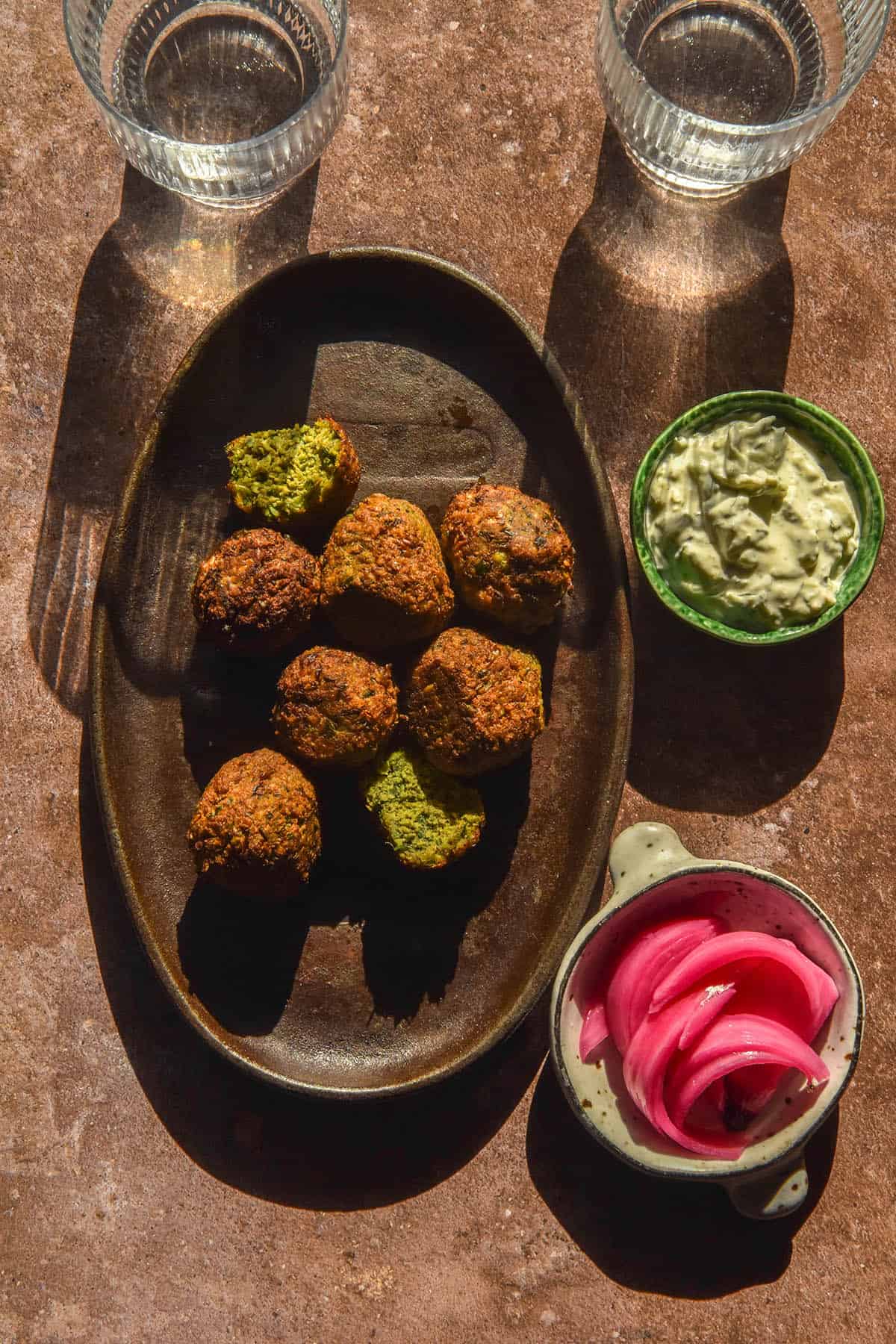
Low FODMAP falafel
This low FODMAP falafel recipe is absolutely not traditional. Soaked chickpeas don’t even have an entry on the Monash FODMAP app. Soaked, boiled and drained chickpeas are low FODMAP in 29g (approximately 1 1/2 tablespoon) serves. So, either of these options would make for a very small or non existent serve of falafel.
To further complicate the issue, chickpea flour (often used to form a batter consistency) is high FODMAP in all serves. Not ideal!
So, how does one make a low FODMAP falafel? We use edamame beans! Absolutely not traditional to falafel, these neutrally flavoured beans are low FODMAP in 75g serves. However, they don’t contain moderate amounts of fructan until they exceed 195g serves per person, which makes them an excellent choice for a falafel.
To substitute the chickpea flour, we’re using buckwheat flour (I promise you can’t taste it!). Buckwheat has elasticity that no other gluten free flour has. This helps bind the falafel together.
Fresh flat leaf parsley and coriander add a herbaceous element and cumin adds flavour. That’s it! An easy and delicious gluten free, low FODMAP falafel recipe.
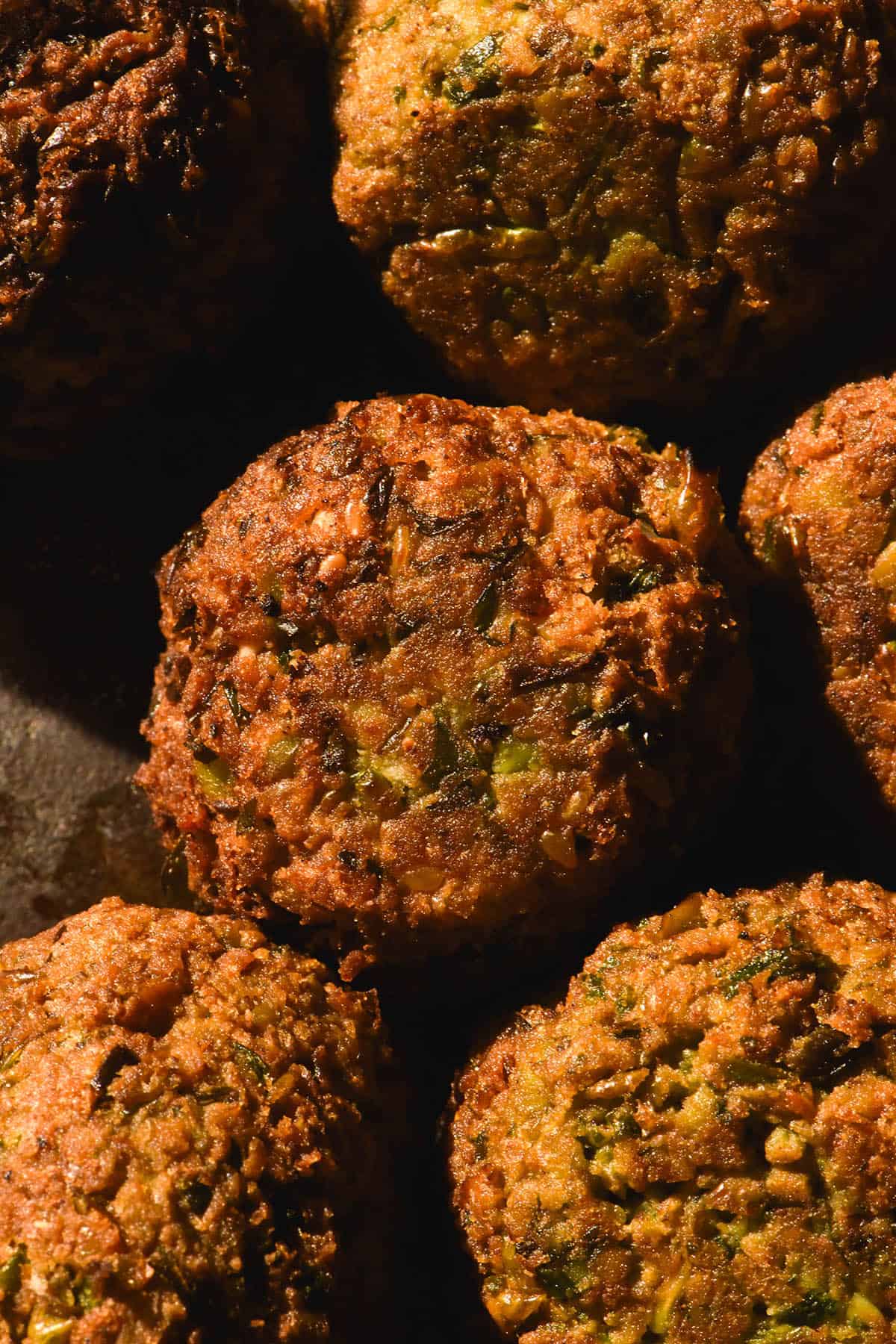
FODMAP notes
These thresholds are current as of June 2025 as per the Monash FODMAP app. They will be periodically reviewed and updated to ensure they remain current.
Edamame is low FODMAP in 75g serves and up to 195g. In larger serving sizes, it contains moderate amounts of fructans.
When I developed this recipe, I made it using half chickpeas and half edamame. and the predominant FODMAP in canned chickpeas was GOS. This was my inspiration to split the legume content between edamame and chickpeas. However, Monash have updated the chickpea entry to say that fructans are the predominant FODMAP. Now, both legumes contain the same FODMAP, but reach the threshold at different points.
As such, I now recommend making the edamame only version. It becomes tricky to balance two fructan containing ingredients with different thresholds, so the edamame only version is a streamlined option.
If you make a completely edamame version, you can still eat 3 falafel per serve and remain under the lowest FODMAP threshold. However, you can also experiment with eating more (remember, the moderate threshold for edamame is 195g). If each falafel contains 25g of edamame (250g total edamame divided by 10 falafel) you could eat up to 7 1/2 felafel and consume 200g of edamame, pending your own tolerance.
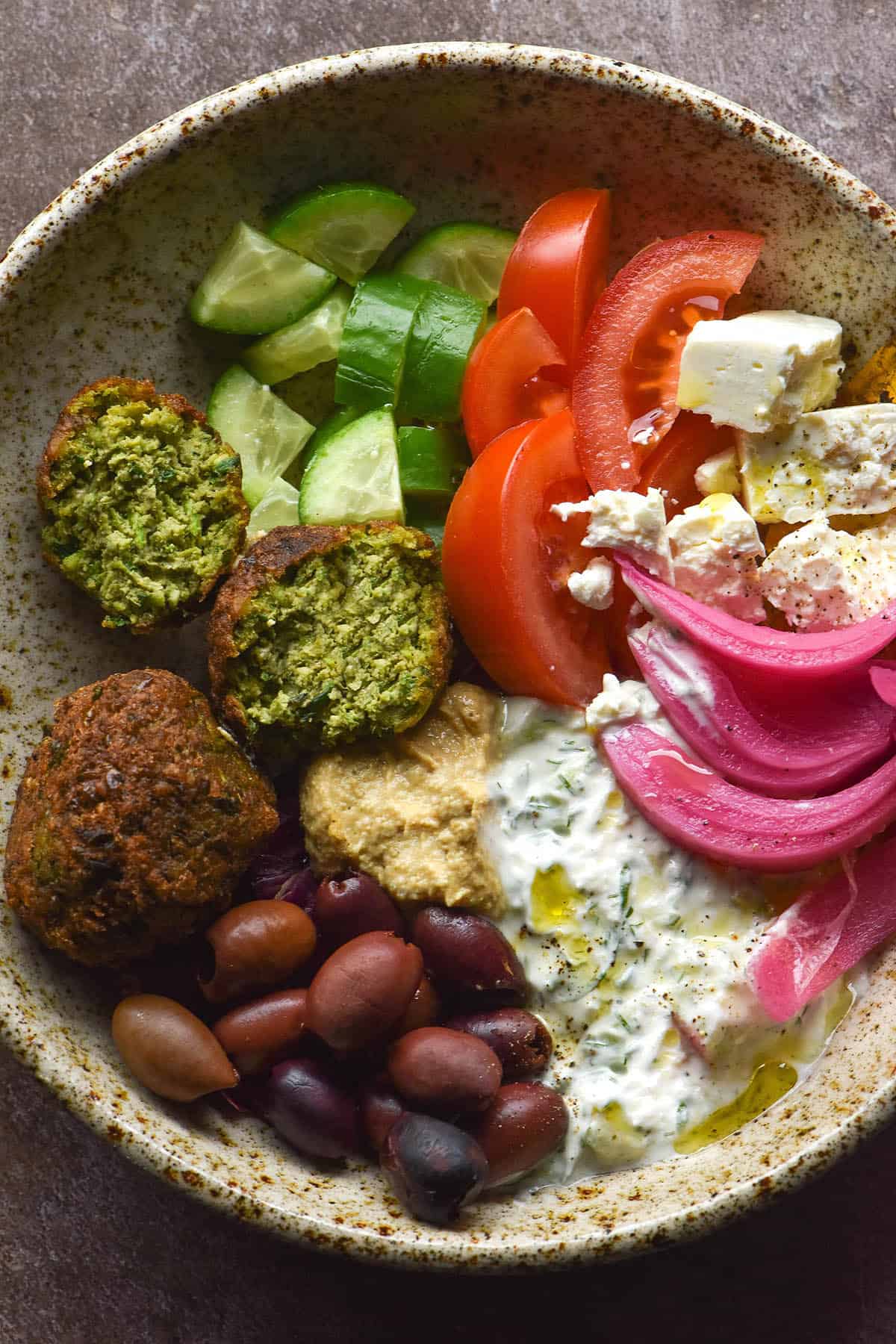
Why are they no longer half chickpea and half edamame?
I started with this combination for a number of reasons. Firstly, I started with canned chickpeas as a nod to the modern falafel. I didn’t want to create something so far off the map of what falafel is supposed to be. Upon researching, though, I learned that falafel used to be made with fava beans (broad beans) which are similar in taste, texture and colour to edamame.
Secondly, I chose to split the legume content to spread the FODMAP load between two FODMAPs – the GOS in chickpeas (which Monash has since updated to fructans) and the fructans in edamame.
Thirdly, I needed a firmer, drier variety of bean to ensure the falafel weren’t soggy inside. Edamame is the only low FODMAP legume that isn’t (always) canned.
Finally, the colour! I wanted to make falafel that were bright green inside. Herbs help, but the lovely colour of edamame is really what gives them a green interior.
As discussed above, I have changed the recipe to be all edamame in line with a Monash FODMAP update. However, if you have made the original recipe and had no issues, you can continue to make the falafel that way. Use 250g canned and rinsed chickpeas and 250g edamame.
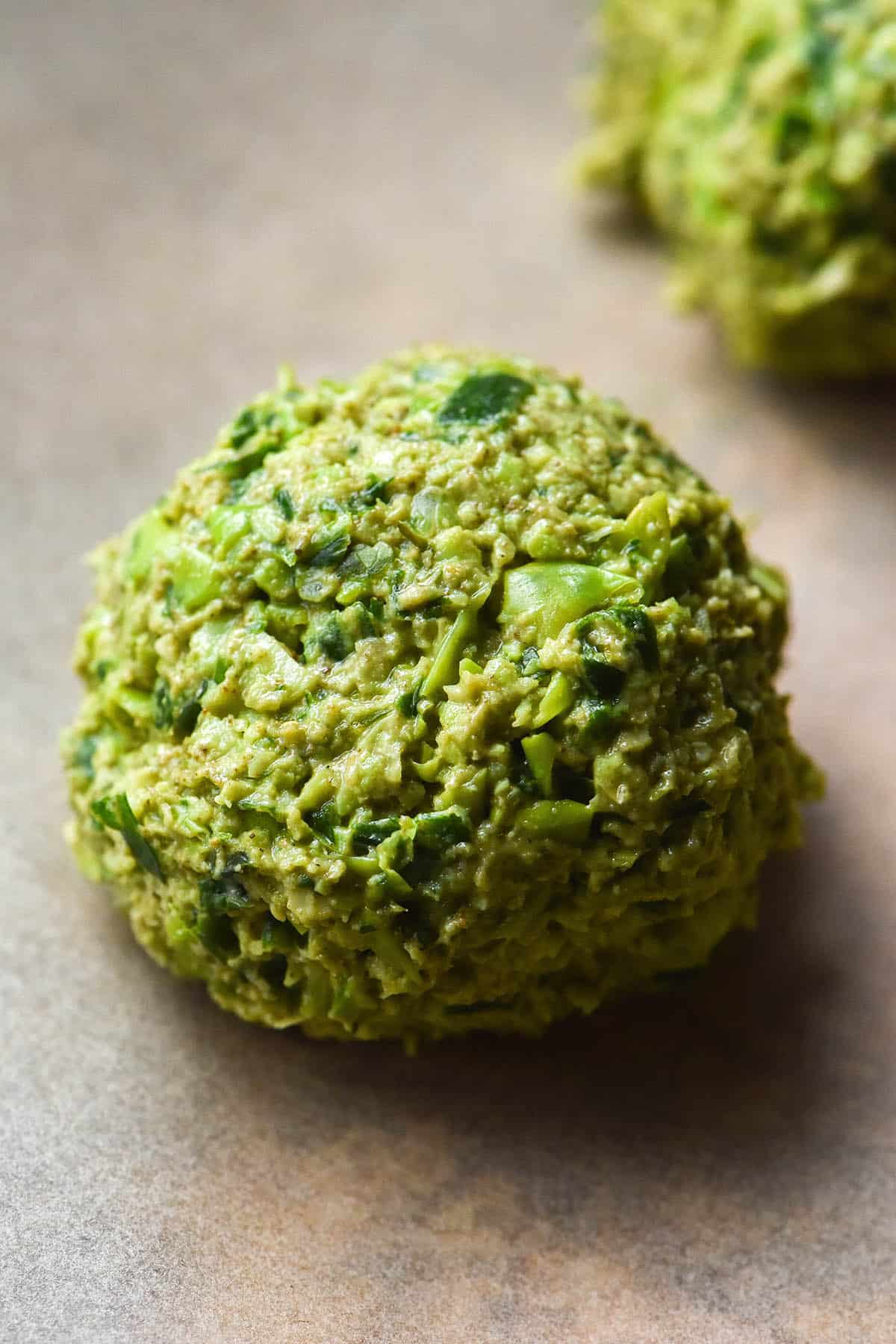
Can these low FODMAP falafel be baked and fried?
Yes! I have tested them both ways and they worked well. Oven baked are a touch drier than shallow fried, but they still retain internal moisture either way.
The instructions for both methods of cooking your falafel are in the recipe card.
In terms of which I prefer: to me, shallow fried felafel are the most authentic tasting version. The shell of the falafel is deliciously crispy without being dry. They also look the best (to me).
With that said, shallow frying can be intimidating, make sure your house smell of smoke, set off the fire alarm (just me?) etc. There are pros and cons to both, so choose what works for you!
I haven’t tried air frying them yet (I still don’t own an air fryer, if you can believe that!) but I feel like it would work well.
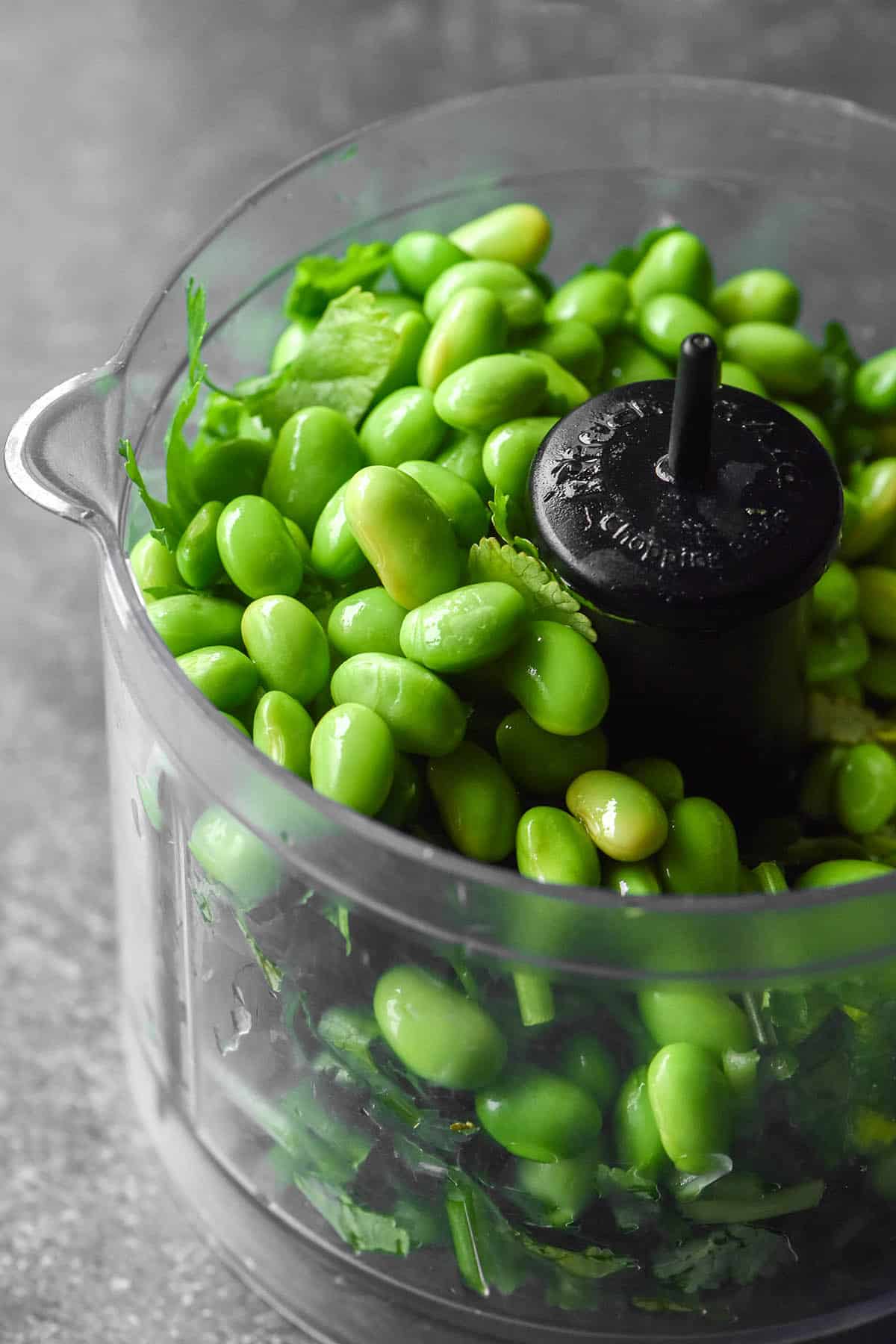
Tips for your low FODMAP falafel
- The ideal texture of your falafel mixture is cohesive with small chunks – not fully blended to the point of having no texture. I use a mini KitchenAid food processor that I generally grind curry pastes in. You could also try putting your ingredients in a tall jar and using an immersion blender to blend.
- This falafel mixture becomes too salty very quickly. This is why I recommend adding it to taste after blending.
- The chickpea and edamame filling has a more ‘creamy’ texture whereas the edamame only version has a crunchier inner texture. See the FODMAP section for more information on the chickpea option.
- This recipe makes 10 small falafel that are 1 Australian tablespoon (4 teaspoons elsewhere) each. If you make them bigger you will need to calculate the FODMAP content yourself.
- In Australia, edamame are generally sold frozen in the Pan Asian section of major supermarkets. For the uninitiated: look for the shelled beans rather than those in pods. The beans need to be shelled from the pods and it takes forever to get 250g edamame beans. Do not use the pods in this recipe – beans only. If you buy podded edamame, weigh them after shelling them and discard the pods.

More low FODMAP bean recipes
- Low FODMAP minestrone
- Low FODMAP lentil soup
- Low FODMAP quinoa bake with Mexican inspired flavours
- Low FODMAP vegan chilli
- Low FODMAP vegan sausages (tofu is a bean, OK?)

Low FODMAP falafel (vegan, gluten free)
Ingredients
- 250 g frozen edamame beans, defrosted
- 50 g coriander (1/2 large bunch)
- 50 g flat leaf parsley (1/2 large bunch)
- 40 ml (2 tablespoons)* olive oil
- 4-5 spring onion greens chopped
- 1-2 pickled garlic cloves (optional, see notes)
- 3-4 + tsp cumin to your tastes (7.5-10g+)
- 40 g+ light buckwheat flour
- 5 g (1 tsp)* baking powder (gluten free if necessary)
- 2-4 g fine table salt (important, see notes) to your tastes
- Pepper to your tastes
- Optional: 1 tablespoons sesame seeds
Instructions
To make the falafel:
- Place your edamame, herbs, oil, spring onion greens and (optional) pickled garlic in a food processor and blitz until a paste with very small chunks forms. It won’t hold together just yet – the buckwheat will do that.
- You may need to add up to 60ml (1/4 cup) water to help with blending. Try to add it sparingly and only as needed.
- Once you are happy with the consistency, pour the mixture into a small mixing bowl.
- Add the cumin, buckwheat flour and baking powder and stir to combine. The mixture should hold together and be the right consistency to make balls of falafel with your hands. If it doesn't, add 5-10g extra buckwheat flour (be sparing as too much flour will make them pasty and dry).
- Add the salt sparsely, carefully and to taste. I find this falafel mixture becomes too salty very easily (coming from someone who loves salt). I would recommend adding 1/8 or ¼ of a teaspoon, mixing thoroughly and tasting. If it tastes bland and like nothing, add a little more salt. If it tastes full flavoured, stop adding more salt. Add pepper to your tastes.
- Use oiled hands to form the mixture into 10 X 1 tablespoon sized balls. Note: 1 Australian tablespoon is 4 teaspoons elsewhere.
To shallow fry:
- Fill a small, sturdy saucepan with enough neutral high smoke point oil (I used vegetable) to cover the bottom half of one felafel. Preheat it over your smallest burner on a high flame for approximately 5 minutes.
- Once it is very thoroughly heated, add one falafel into the oil. It should form a ring of vigorous bubbles all around the falafel. If it doesn’t bubble like this or if the falafel gets stuck, your oil is not hot enough. The falafel won’t stick at all when cooked in sufficiently preheated oil. Stop and allow the oil to heat for another few minutes before trying again.
- Cook the falafel for around 30 seconds – 1 minute or until the bottom half is golden brown. Use tongs to flip the falafel and cook on the other side. Transfer to a cooling rack and repeat with the remaining falafels.
To bake:
- Preheat the oven to 200C/400F. Line a large baking tray with baking paper.
- Drizzle about ½ teaspoon olive oil on your hands every time you shape a falafel. Arrange them on the baking tray then bake for 20 minutes. They won’t be golden brown all over like the fried version. However, I have found that baking the falafel for longer creates dry falafel.
To finish:
- Serve the falafel with whatever you’d like (some suggestions in the body of post). Leftovers keep well in the fridge for a number of days. They can also be frozen and defrosted.
Notes
- I have written extensively in the body of post concerning the FODMAP content and the option to use all edamame vs half chickpea and half edamame.
- I updated the recipe card to be all edamame due to a change on the Monash FODMAP app regarding the FODMAP in canned chickpeas.
- If you’d like to make the original recipe, use 125g canned chickpeas and 125g edamame.
- I have not tested canned edamame in this recipe.
- This falafel mixture can become too salty very easily. I highly recommend adding it to taste and sparingly.
- Pickled garlic is a relatively new low FODMAP ingredient. There are FODMAP notes in the body of the post; I have a recipe for low FODMAP pickled garlic here.
- If you use the chickpea and edamame mixture, 3 falafel is a low FODMAP.
- If you use the edamame only mixture, you can eat 3-4 falafel and possibly more pending your fructan tolerance. See the body of the post for more details.

I have been having moral issues with meat for awhile now but navigating low FODMAP and meatless is a daunting task for me and I miss falafel so much! I’m going to use garlic infused olive oil and cook these in the air fryer. I’ll come back and let you know how it went.
These turned out really well! They looked just like yours! Your directions were precise and easy to follow! Doubled the recipe so I could freeze some, but amount was too large for my processor and had to blitz them in 2 batches. Oh well. Air fried them. Whole family liked them. Thank you SO, SO much for developing these!!!
I’m so glad you enjoyed them Denise! Great to know they work in an air fryer to (I desperately need to get one I think)
🙂
Can you use almond flour? I don’t want to spend $ on buckwheat flour and use what I have on hand. Thanks.
I haven’t tested this but I am concerned that almond meal will lack the elasticity that buckwheat has, meaning the falafel won’t hold together and also brown very quickly if you fry the falafel in oil because of the natural fat in almond meal.
You’re welcome to try it but I do have my reservations and have unfortunately only tested buckwheat flour 🙂
Just made these, and they were fabulous! I used 200g edamame frozen/defrosted, but couldn’t get another packet, so topped up with 50g of tinned. I didn’t have pickled garlic (but very excited to pickle some) and used garlic olive oil instead of olive oil. I baked them and they were tasty and not dry! Served with salad and don’t condiments. Definatly adding these to the list of easy weeknight meals! Thankyou for sharing the recipe!
I am so glad you enjoyed them! Good to know they work with a frozen and tinned combo, I have been meaning to try 🙂